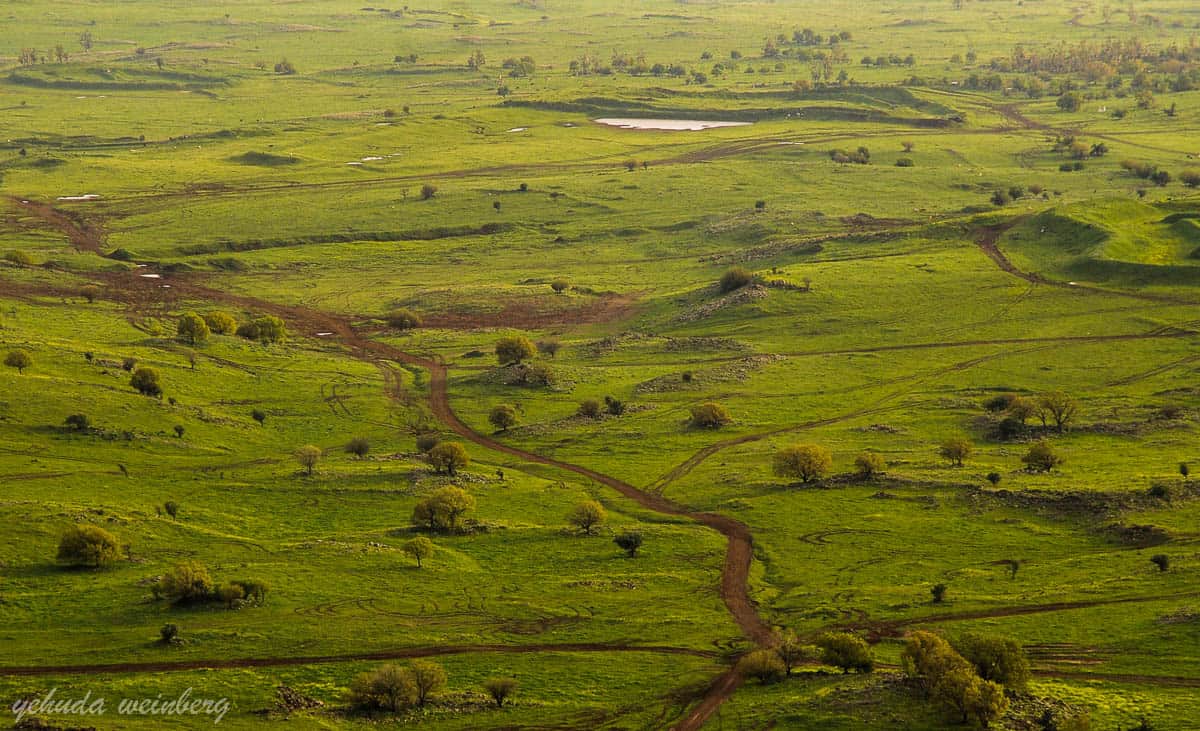The rest of the Brigade forces, commanded by Ran Gottfried, arrived at Nafach in the afternoon, meeting Syrian forces there totally by surprise. It turns out that the enemy did not attack from the east, but rather from the south via Sindiana and the TAP-Line Road all the way to the IDF Headquarters at Nafach. From there, the Syrian force threatened the rear flank of the 7th Brigade, as well as the bridges over the Jordan River, which were only a 10-minute drive away. Ran Gottfried’s tank force was being hit by the Syrian forces, but they were returning fire and holding back the Syrian advance.
When IDF Northern Command realized the serious situation in Nafach, they gave the order to the commander of the 679th Brigade to move towards Nafach base. The commander moved south and then turned west on the road that stretches below us between Tel Shifon and Mt. Yosifun. In the area of Delhamia, this force ascended to take firing positions, and began hitting the flank of the Syrian 91st Brigade that were stationary on the Sindiana ridge and north of it. At the same time, a secondary force commanded by Raful Shefer moved from the Kuneitra Valley on the Ein Zivan Road, hitting Syrian tanks that were crossing the Nafach Road. The last Brigade force, commanded by Chaim Danon, arrived in the afternoon to Nafach, passed the base on the south, and hit retreating Syrian tanks. In the evening of October 7th, the brigade completed its mission of clearing out Nafach base from any enemy forces. They began preparing for the next day of battle.
All night long, a new brigade force was being built. The Deputy Brigade Commander, Levi Mann, rallied together all relevant brigade units. They helped in repairing tanks and finding the right soldiers to man them. When dawn broke, the brigade had 60 tanks in three forces under the command of Moshe Harel, Chaim Danon, and Amnon Rimon. The forces spread out in wide formation from the Ein Zivan Ridge in the north, all the way to Nafach and the TAP-line road in the south.
At first light on Monday, October 8th, Syrian forces began heavy artillery shelling, after which a large unit of Syrian tanks began attacking, with the help of anti-tank missiles from the slopes of Mt. Yosifun and Ein Varda. The Syrians wanted to recapture Nafach.
The IDF Brigade forces fought the Syrians at close range, and many tanks and many soldiers were hit, including Battalion Commander Amnon Rimon, who was killed. But the Syrian attack broke, and they began their retreat; the brigade saw this and utilized the retreat to capture the strategic Sindiana Hills in the south and east, as well as Mt. Yosifun (seen on our left). Despite the loss of lives and manpower, the brigade continue to attack in the afternoon, with the aim of capturing the Ramtaniya Hills; however, the lack of ammunition and fuel convinced the Brigade Commander to retreat to Nafach and reorganize.
At dawn on Tuesday, the brigade was again ready with 60 tanks, waiting in ambush position on the Sindiana and Delhamia Hills opposite the Syrians. The enemy forces again attacked under the cover of heavy artillery fire and anti-tank missiles. The tanks of Unit 679 ascended to attack position and successfully hit many Syrian tanks. The Syrian attack was stopped at the Ein Varda line, and in the afternoon the brigade again set out to attack the Syrians and capture the Ramtaniya Hills that control Hushniya Junction.
The IDF tanks moved without stopping, firing as much as they could, destroying many Syrian tanks. As darkness fell on the battlefield, the Ramtaniya Hills were lit up by the flames of tens of destroyed Syrian tanks. At the same time, other IDF reserve forces attacked the area of Hushniya from the south. By Wednesday, October 10th, the entire area was cleared of all Syrian forces, and the IDF again had total control of the Golan Heights.
The fierce determination of the commanders and soldiers of the 679th Brigade to fulfil their mission, prevented the Syrians from capturing the Golan, allowing for a decisive IDF victory over the Syrians by the end of the war.
The Breakthrough
On Thursday, October 11th, the IDF began their offensive, advancing and attacking into Syria proper; their goal was to be able to threaten Damascus, thereby taking Syria out of the war, and allowing for an IDF crossing of the Suez Canal on the Egyptian Front in the south. As the force was about to cross over into Syria, it rearranged itself into four units, commanded by Moshe Harel, Chaim Danon, Sassi Keren, and Amos Ben-David. The main route to Damascus was well-defended and fortified by the Syrians, especially near the village of Khan Arnabeh; there were dug-in tanks, infantry posts, anti-tank canons, and minefields.
The attack on the road near Khan Arnabeh was led by the IDF 179th Brigade, commanded by Ran Sarig. The brigade was halted at the entrance to the village after sustaining many casualties. The IDF 679th Brigade continued moving eastward, passed the 179th Brigade, also sustaining many casualties; among them Amos Ben-David, who was killed, and Moshe Harel, who was wounded for the second time.
The brigade stopped to reorganize at the foot of Tel Shaar.
On the next day, Friday, October 12th, another force joined the brigade, led by Natti Golan; most of the force’s soldiers had recently returned from overseas. Natti’s force led the attack to the southeast towards Kafr Nasij; they ran into a Syrian ambush, and lost a few tanks, with Natti injured.
The 679th Brigade didn’t stop. They continued to attack, captured Tel Korin, and forced the entire Syrian army to retreat from the area. While waiting in Kafr Nasij, they received an urgent message that a special Iraqi force was on their way to attack them from the direction of Tel Antar. The few remaining tanks of 679 quickly moved into position opposite the enemy forces, destroyed part of them, and caused the rest of the enemy to retreat.
In the coming days, until the cease-fire, the brigade fought against Jordanian, Iraqi, and Syrian forces, thereby setting the eastern border of the IDF presence in Syria. The brigade’s soldiers were released from reserve duty only after Passover of 1974, after seven straight months of fighting.
In the Yom Kippur War, one of the biggest tank battles since World War II took place in the Golan Heights. Out of 1300 Syrian tanks that attacked Israel in the Golan, almost 1100 tanks were left damaged and abandoned in the area controlled by the IDF. Six days after surprising the Israeli forces, the Syrians found themselves surprised and hurting in their own territory, with Damascus in canon range of the IDF.
The 679th Brigade lost 75 of its best commanders and soldiers in the war. The Brigade Association, established after the wear by Deputy Brigade Commander Levi Mann, was created in order to commemorate the memories of its fallen soldiers. They were responsible for building the memorial at the foot of Mt. Shifon where you are now standing. You are welcome to visit the memorial and pay your respects to the fallen.









